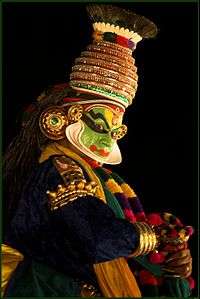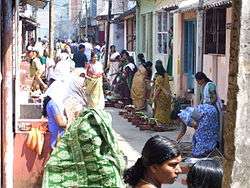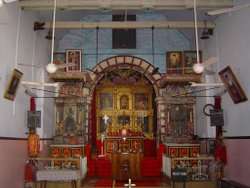Ethnic groups in Kerala

This article gives an overview of the ethnic groups in Kerala, a state in India. The speakers of Malayalam language form the great majority of people Kerala. They are a heterogeneous group and have distinctive cultural and religious traditions. Various ethnic groups with origins in other parts of India as well as other parts of the world. They have unique customs and may speak languages other than Malayalam, adding to the rich cultural diversity of the state.[1][2]

Ethnic history
Racial and ethnic history of Kerala is highly controversial and disputed among the cultural anthropologists, historians and other scholars. The people of Kerala, known as "Malayali" (people speaking Malayalam language), is polygenetic and belong to different ethnic groups and religions. The national Census of India does not recognise racial or ethnic groups within India.[3][4] According to a 2009 study published by David Reich et al., the modern Indian population is composed of two genetically divergent and heterogeneous populations which mixed in ancient times, known as Ancestral North Indians (ANI, Indo-Aryan-speaking population) and Ancestral South Indians (ASI, Dravidian-speaking population).[5]
- Negrito element: the earliest racial strain in the population of Kerala as of South India in general. These people still live in forests of Kerala state. Most of these tribes' have curly hair, black skin, round head and broad nose.[6]
- e.g.: Hill tribes such as Kadar, Kanikkar, Malapandarams, Mutuvans, Ullatans, Uralis, Paniyas etc.[6]
- Proto-Australoids: the Negritos were probably replaced by Proto-Australoids. These people have flat nose and dark skin.[6]
Malayali
Malayalis are the native people of Kerala who speak Malayalam, the official language of the state. (Malayalam: മലയാളo). The Malayalam language is a Dravidian language closely related to Sanskrit and Tamil which crystallised into a distinctive tongue only at the beginning of the medieval era. Similar to other major languages, modern Malayalam includes words loaned from Portuguese, Arabic, Syriac, and in more recent times English.[7] While the majority of Malayalis live in Kerala, significant populations also exist in other parts of India, the Middle East, Europe and North America. According to the Indian census of 1991, there were 28,096,376 speakers of Malayalam in Kerala, making up 96.66% of the total population of that state.
The majority (about 54%) of the Malayali people are Hindu, mostly of the Ezhava and Nair and Thiyya communities, but there are also large Muslim (24%) and Christian (18%) communities.[8] The Muslim community, or Mappilas, trace their origins far back to early contacts with Arab traders before the start of the Christian era, and mostly follow the Shafi`i school of Sunni Islam. Many speak the distinctive Mappila dialect of Malayalam.[9] There is also a sizable population of Rowthers,who have a Turkish ancestry.Majority of the Christians belong to Saint Thomas Christian community, and are also known as Syrian Christians or Nasrani.[10] The descendants of the Cochin Jews who have traditionally followed Halakhic Judaism are known as Juda Mappila.[11]
Tamil
Since time immemorial, there have been frequent migrations to Kerala from the neighbouring state of Tamil Nadu. The history of ancient Kerala itself is deeply intertwined with Tamil Nadu's ancient past, and the Tamil and Malayalam languages are closely related. The dialect of Tamil spoken today in the district of Palakkad in Kerala has a large number of Malayalam loanwords, has been influenced by Malayalam syntax and also has a distinct Malayalam accent.[12]
Some of the earliest migrations attested by history were those of Iyers from the Cauvery delta to the district of Palakkad. The first of these migrations are believed to have taken place over five hundred years ago. These Iyers settled in Palakkad where they owned land and led an affluent existence till the enactment of the land reforms in the 1960s. They followed many Malayali practices include the practice of sambandham. There have also been migrations of Iyers to the princely state of Travancore from the Tirunelveli district during the 18th and 19th centuries. These Iyers are called Kerala Iyers and differ significantly from Palakkad Iyers in their language and social status. Some of Travancore's diwans were Tamil Brahmins.[13][14]
Apart from Iyers, many other Tamil communities also migrated to Kerala between the 18th and the 20th century when the southernmost Kanyakumari district of Tamil Nadu was a part of the Travancore kingdom. The capital of the Travancore kingdom which ruled over most of Kerala was located in Padmanabhapuram in present-day Tamil Nadu. The caste system in Kerala is very similar to that which exists in the southern districts of Tamil Nadu.[15]
Kerala is also the home to a sizable population of Sri Lankan Tamils who arrived as refugees as a result of the Sri Lankan civil war, as well as Tamils of South Indian origin who were displaced due to the Ceylon Citizenship Act and the Anti-Tamil pogroms by the Sri Lankan government. The latter who number close to 10,000, are mainly found in eastern parts of the Kollam district where they work in rubber plantations under the Government of Kerala initiative Rehabilitation Plantations Limited which became the first public sector plantation company in the country to be granted the ISO 9002 certificate.[16]
Vellalars migrated from Tamil Nadu to eastern parts of Kerala like Idukki district, Pathanamthitta District. They are prominently found in Erattupetta, Pala, Ponkunnam, Kanjirappalli, Thodupuzha, Pathanamthitta etc. Similarly, Tamil Muslims migrated the same route from Madurai to Thodupuzha, Irattupetta, Pathanamthitta regions. They are distinct from Malayalam speaking Mappila Muslims in many ways including the usage of a dialect of Tamil inside their houses
Tulu
Shivalli Brahmins living all over the Indian state of Kerala are part of the larger Tulu Brahmin subsect primarily found in the Indian state of Karnataka but also in the Kasaragod district and Kannur of Northern Kerala. Their mother tongue is Tulu. Brahmins from Tulunadu may have migrated to Kerala before the first century C.E.[17] Today, there is a sizeable Tulu Brahmin population in Thiruvananthapuram and elsewhere in the state.[18]
Kannada
Kannada is one of the major languages of India, spoken predominantly in the state of Karnataka. Kannadigas (ಕನ್ನಡಿಗರು Kannadigaru), number roughly 50 million, making it the 15 most spoken language in the world.[19] It is one of the official languages of India and the official and administrative language of the state of Karnataka.[20] Kannada people constitute a significant portion of the population of the district of Kasargod in North Kerala. Kannada is also an administrative language in the district.
Konkanis
Cochin GSB's are a branch of the Konkani language speaking Gaud Saraswat Brahmins community of India belonging originally to Karnataka and Goa, who form the majority of Konkanis is Kerala. GSBs of Cochin form the southernmost subsect of Saraswat Brahmins of West coast. GSBs of north Kerala are same as GSBs of Canara in speech and customs, whereas GSBs of Cochin and Travancore have developed their own Konkani dialect and Customs, which distinguish them from rest of GSB community, this subsect is now called Cochin GSBs. In Geographical terms, Cochin GSBs are those who live south of Thrissur district of Kerala.[21] Other Konkani speaking Minirities in Kerala include the Kudumbis, Daivajnas,and the Vaishya Vani.All these groups had migrated from Goa within last few centuries for various soci-economic reasons.
Mahls
There are about 10,000 speakers of the Mahl language in Kerala. Most Mahl speakers are temporary residing people from neighbouring Maldives. Other Mahl speakers are from Indian island of Minicoy and most of them live in Trivandrum.
Smaller minority groups
Gujaratis
There are about 500 Gujarati families living for many generations in Kochi, the commercial hub of Kerala. Gujarati community is composed of various social groups like Jains, Saurashtris and Kutchis in the Indian state. The Gujarati Street at Mattancherry in the city is a main Gujarati cultural icon in Kerala.[22] Calicut & Cannanore also has a sizeable population of Hindu and Jain Guajaratis.[23] They are basically business people doing all forms of wholesale and retail trade. There is a Gujarati Higher Secondary School near Calicut Beach.[24]
Sikhs
Kochi is home to the Punjabi speaking Sikh community in Kerala as the coastal city has the most number of Sikhs in the south Indian state. Many of the Kerala's Punjabi Sikh community are in the automobile spare parts industry.
Other minorities
Kerala also have a small number of scattered Bengali, Bihari and Oriya communities.
List of mother tongues spoken in Kerala by number of speakers



(Excluding the tribal population)[25]
| Language | No. of speakers | % of population |
|---|---|---|
| Malayalam | 28,096,376 | 96.66 |
| Tamil | 616,010 | 2.12 |
| Kannada | 325,571 | 1.2 |
| Tulu | 111,670 | 0.38 |
| Konkani | 64,008 | 0.22 |
| Telugu | 47,216 | 0.16 |
| Hindi | 21,751 | 0.07 |
| Urdu | 12,625 | 0.04 |
| Gujarati | 6,369 | 0.02 |
| English | 3,002 | 0.01 |
| Punjabi | 2,201 | 0.008 |
| Bengali | 1,919 | 0.007 |
| Nepali | 1,312 | 0.005 |
| Sindhi | 1,185 | 0.004 |
| Oriya | 733 | 0.003 |
| Dilli | 277 | 0.001 |
| Assamese | 264 | 0.001 |
| Arabic | 243 | 0.001 |
| Other languages | 4256 | 0.15 |
| Total | 29,067,481 | 100% |
Religion and Community



According to the 2001 census[8] the breakdown of ethnic groups by religion is:
| Malayalam | Other languages | Total | |
|---|---|---|---|
| Hindu | 54.20% | 2% | 56.20% |
| Muslim | 23.70% | 1% | 24.70% |
| Christian | 18.00% | 1% | 19.00% |
| Other religions | <0.1% | <0.1% | 00.10% |
| Total | 96.00% | 4.00% | 100.00% |
1968 Socio-Economic Survey of Kerala
In 1968, the Communist government under E. M. S. Namboodiripad ordered a socio-economic survey of each resident in the state of Kerala, to assess caste inequalities. Until the census of 2011, this survey was the only caste-based count conducted in post-independence India. The survey was not very conclusive, since it merged several unrelated castes in to one group (for example, Ambalavasis and Tamil Brahmins were grouped along with Malayali Brahmins).
The survey found that individuals belonging to higher castes possessed more land and had relatively higher per capita income as compared to the general population. The survey found that 33% of the states population was forward caste, almost half of whom were Syrian Christians. According to the survey, 13% of the Brahmins, 6.8% of the Syrian Catholics, 5.4% of the Jacobites and 4.7% of the Nairs owned more than 5 acres of land. This compared with 1.4% of the Ezhavas, 1.9% of the Muslims and 0.1% of the Scheduled Castes who had that much land in their possession.[26]
| Caste | Population | Percentage |
|---|---|---|
| Brahmin | 353,329 | 1.76% |
| Nair | 2,905,775 | 14.46% |
| Nair Other | 435,396 | 2.17% |
| Kammalar | 756,178 | 3.76% |
| Vellalar / Chetty | 151,150 | 0.75% |
| Kaniyan / Izhava / Nadar | 4,457,808 | 22.19% |
| Arayan / Mukkuvan | 851,603 | 4.24% |
| Scheduled Castes | 1,578,115 | 7.85% |
| Ezhuthachan | 260,042 | 1.29% |
| Syrian Christian (Nasrani) | 3,214,278 | 16.00% |
| Latin Catholic & Anglo – Indian | 731,207 | 3.64% |
| Christian Scheduled Caste | 301,912 | 1.50% |
| Muslim | 3,842,322 | 19.12% |
| Scheduled Tribe | 253,519 | 1.26% |
| Total | 20,092,634 | 100.00% |
The last comprehensive caste census of Kerala was undertaken by the British in 1931 (the Census of 1941 also asked caste, but the tables were never published).[27]
| Caste | Population (1931) | Percentage (1931) |
|---|---|---|
| Malayali Brahmin | 50,240 | 0.51% |
| Foreign Brahmin | 121,748 | 1.24% |
| Ambalavasi Brahmin | 39,371 | 0.40% |
| Samanta Kshatriya | 5,901 | 0.06% |
| Samanthan Nair | 4,921 | 0.05% |
| Nair | 1,505,929 | 15.30% |
| Vilakkithala Nair | 35,199 | 0.36% |
| Veluthedath Nair | 22,219 | 0.23% |
| Kammalar | 265,752 | 2.70% |
| Vellalar | 88,584 | 0.90% |
| Chetty | 49,213 | 0.50% |
| Izhava + Thiyya | 2,007,901 | 20.40% |
| Kaniyar | 39,371 | 0.40% |
| Mukkuvar + Arayar | 88,584 | 0.90% |
| Parayar | 165,656 | 1.68% |
| Pulayar + Cherumar | 678,387 | 6.89% |
| Kuravan | 95,295 | 0.97% |
| Thandan | 41,214 | 0.42% |
| Nadar | 402,555 | 4.09% |
| Syrian Christian | 1,197,553 | 12.17% |
| Non-Syrian Christian | 807,686 | 8.21% |
| Muslim | 1,604,629 | 16.30% |
| Total | 9,842,650 |
See also
Notes
- ↑ Śr̲īnāthan, Eṃ (2006). Kēraḷattile bhāṣakaḷ. Tiruvantapuraṃ: Antārāṣtr̲a Kēraḷapaṭhanakēndraṃ. ISBN 81-87590-11-4.
- ↑ Maṇalil, Pōḷ (2006). Kēraḷattile bhāṣānyūnapakṣaṅṅaḷ : sāmūhika caritr̲aṃ. Kolzhikode: Mātr̥bhūmi Buks. ISBN 81-8264-226-4.
- ↑ Kumar, Jayant. Census of India. 2001. 4 September 2006. Indian Census Archived 12 May 2008 at WebCite
- ↑ Dr. E, J. Thomas,"The People of Kerala," The St. Thomas Christian Encyclopaedia of India, Ed. George Menachery, Vol. II, 1973, p.185 et. sq.
- ↑ Reich, David; Thangaraj, Kumarasamy; Patterson, Nick; Price, Alkes L.; Singh, Lalji (2009). "Reconstructing Indian population history". Nature. 461 (7263): 489–94. doi:10.1038/nature08365. PMC 2842210
 . PMID 19779445.
. PMID 19779445. - 1 2 3 Menon, A Sreedhara; "A Survey of Kerala History"; D C Books, 1 January 2007 – History – pp 54–56
- ↑ George, K.M (1972). Western influence on Malayalam language and literature. New Delhi: Sahitya Akademi. ISBN 81-260-0413-4.
- 1 2 Linguistic minorities of Kerala
- ↑ Kerala History Deepthi.com. Retrieved 10 March 2009 .
- ↑ Gantz Brothers, Land of the Perumals 1863
- ↑ Bindu Malieckal (2005);
- ↑ Thiru. Mu. Kovintācāriyar, Vāḻaiyaṭi vāḻai Lifco, Madras, 1978 at pp. 26–39.
- ↑ "History of Kerala iyers and Agraharams". Kuzhalmanna Agraharam website. Retrieved 2008-08-27.
- ↑ "Migration Theories". keralaiyers.com. Retrieved 2008-08-19.
- ↑ Towards Modern Kerala, 10th Standard Text Book, Chapter 9. Archived 17 December 2008 at the Wayback Machine. www.education.kerala.gov.in
- ↑ "Rubber Boom Raises Hope Of Repatriates". Counter Currents. Retrieved 20 August 2014.
- ↑ Kerala History Udupi Madhwa Brahmana Sabha (Kerala). Retrieved 9 March 2009.
- ↑ The History of Shivalli Brahmins Kakkilayas of Bevinje. Retrieved 9 March 2009.
- ↑ Languages Spoken by More Than 10 Million People. Encarta. Archived 31 October 2009 at WebCite 2009-10-31.
- ↑ "The Karnataka Official Language Act" (PDF). Official website of Department of Parliamentary Affairs and Legislation. Government of Karnataka. Retrieved 2007-06-29.
- ↑ Kudva, Venkataraya Narayan (1972). History of the Dakshinatya Saraswats. Samyukta Gowda Saraswata Sabha.
- ↑ It's Dandiya time again The Hindu. Retrieved 9 March 2009
- ↑ The Advent of Gujrathi's in Kerala
- ↑ "Students eager to master life skills". The Hindu. 19 October 2006. Retrieved 10 March 2009.
- ↑ Keralathile Bhashakal (Languages of Kerala) By Dr. M. Sreenadhan. Published by International Centre for Kerala Studies, University of Kerala, Kariavattom, Thiruvananthapuram.
- ↑ http://www.jstor.org/pss/4367366
- ↑ Census 1931 of Travancore (Imper. Table XVII), Census 1931 of Cochin (Imper Table VXII) & Census 1931 of Madras Vol.2, p.306-310